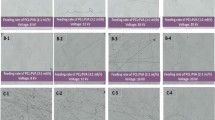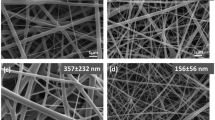Abstract
Biocompatible nanofibers with core-shell structures based on natural polymers such as silk fibroin have multiple applications as tissue engineering scaffolds and drug delivery systems. In this study, core-shell nanofibers composed of silk fibroin as shell and blends of clindamycin and polycaprolactone as core was fabricated using coaxial electrospinning technique. The effects of variation in concentration of core and shell polymer solutions, electrical conductivity and viscosity of solutions on the final morphology, average diameter of nanofibers and release behavior of clindamycin were studied. The fabricated nanofibers and their drug release behaviors were evaluated using Fourier transform infrared spectroscopy, ultraviolet spectroscopy, scanning and transmission electron microscope techniques. The results showed that concentration of shell solution have more effect on the final average diameter of core-shell nanofiber in compare to core solution. It is concluded that as the concentration of both polycaprolactone in the core and silk fibroin in the shell increased, the amount of released clindamycin from fabricated core-shell nanofibers showed decreasing trend.










Similar content being viewed by others
REFERENCES
S. Agarwal, J. H. Wendorff, and A. Greiner, Polymer 49, 5603 (2008).
Y. Y. Yanga, M. Zhanga, Z. P. Liub, K. Wanga, and D. G. Yu, Appl. Surf. Sci. 434, 1040 (2018).
X. Y. Li, Z. B. Zheng, D. G. Yu, X. K. Liu, Y. L. Qu, and H. L. Li, Cellulose 24, 5551 (2017).
S. Agarwal and S. Jiang, Nanofibers and Electrospinning in Encyclopedia of Polymeric Nanomaterials (Springer, Berlin Heidelberg, 2015).
R. A. Perez and H. Won Kim, Acta Biomater. 21, 2 (2015).
B. Sun, B. Duan, and X. Yuan, J. Appl. Polym. Sci. 102, 39 (2006).
N. Zhang, R. Qiao, J. Su, J. Yan, Z. Xie, Y. Qiao, X. Wang, and J. Zhong, Small 13, 1604239 (2017).
A. Vaseashta, “Nanostructured Materials Based Next Generation Devices and Sensors,” in Nanostructured and Advanced Materials for Applications in Sensor, Optoelectronic and Photovoltaic Technology, Ed. by A. K. Vaseashta, D. Dimova-Malinovska, and J. M. Marshall (Springer, the Netherlands, 2005).
Z. Sun, E. Zussman, A.L. Yarin, and J. H. Wendorff, Adv. Mater. 15, 1929 (2003).
D. H. Choi, C. H. Park, I. H. Kim, H. J. Chun, K. Park, and D. K. Han, J. Controlled Release 147, 193 (2010).
Y. Xua, J. J. Lia, D.-G. Yua, G. R. Williams, J. H. Yanga, and X. Wanga, Eur. J. Pharm. Sci. 106, 422 (2017).
Y. Z. Zhang., J. Venugopal, Z. M. Huang, C. T. Lim, and S. Ramakrishna, Biomacromolecules 6, 2583 (2005).
Y. Hang, Y. Zhang, Y. Jin, H. Shao, and X. Hu, Int. J. Biol. Macromol. 51, 980 (2012).
Y. Xia, X. Lu, and H. Zhu, Compos. Sci. Technol. 77, 37 (2013).
M. Maleki, M. Amani-Tehran, M. Latifi, and S. Mathur, Comput. Methods Programs Bio. 113, 92 (2014).
A. Repanas and B. Glasmacher, J. Drug Delivery Sci. Technol. 29, 132 (2015).
W. Shao, J. He, F. Sang, B. Ding, L. Chen, S. Cui, K. Li, Q. Han, and W. Tan, Mater. Sci. Eng., C 58, 342 (2016).
M. Mori, P. V. Almeida, M. Cola, G. Anselmi, E. Makila, A. Correia, J. Salonen, J. Hirvonen, C. Caramella, and H. A. Santos, Eur. J. Pharm. Biopharm. 88, 635 (2014).
M. G. Fouda, R. Wittke, D. Knittel, and E. Schollmeyer, Int. J. Diabetes Mellitus 1, 61 (2009).
A. Mokhtarzadeh, A. Alibakhshi, M. Hejazi, and J. E. N. Dolatabadi, Trends Anal. Chem. 82, 367 (2016).
A. L. Yarin, S. Koombhongse, and D. H. Renekera, J. Appl. Phys. 90, 4836 (2001).
S. C. Kundu, Silk Biomaterials for Tissue Engineering and Regenerative Medicine (Woodhead Publishing, UK, 2014).
X. Zhang, M. R. Reagan, and D. L. Kaplan, Adv. Drug Delivery Rev. 61, 988 (2009).
N. Rahimi Tanha and M. Nouri, J. Ind. Text. 48, 884 (2018). doi 10.1177/1528083717747334
M. Fazley Elahi, W. Lu, G. Guoping, and F. Khan, J. Bioeng. Biomed. Sci. 3, 121 (2013).
C. L. He, Z. M. Huang, X. J. Han, L. Liu, H. S. Zhang, and L. S. Chen, J. Macromol. Sci., Part B: Phys. 45, 515 (2006).
M. A. De Moraes, G. M. Nogueira, R. F. Weska, and M. M. Beppu, Polymers 2, 719 (2010).
T. Elzein, M. N. Eddine, C. Delaite, S. Bistac, and P. Dumas, J. Colloid Interface Sci. 273, 381 (2004).
A. I. Mohamed and A. M. E. Abd-Motagaly, Pharmaceutics 9, 7 (2017).
J. Siepman and F. Siepman, J. Controlled Release 161, 351 (2012).
Author information
Authors and Affiliations
Corresponding author
Additional information
The article is published in the original.
Rights and permissions
About this article
Cite this article
Nadia Rahimi Tanha, Mahdi Nouri Core-shell Nanofibers of Silk Fibroin/Polycaprolactone-Clindamycin: Study on Nanofibers Structure and Controlled Release Behavior. Polym. Sci. Ser. A 61, 85–95 (2019). https://doi.org/10.1134/S0965545X19010085
Received:
Revised:
Accepted:
Published:
Issue Date:
DOI: https://doi.org/10.1134/S0965545X19010085




